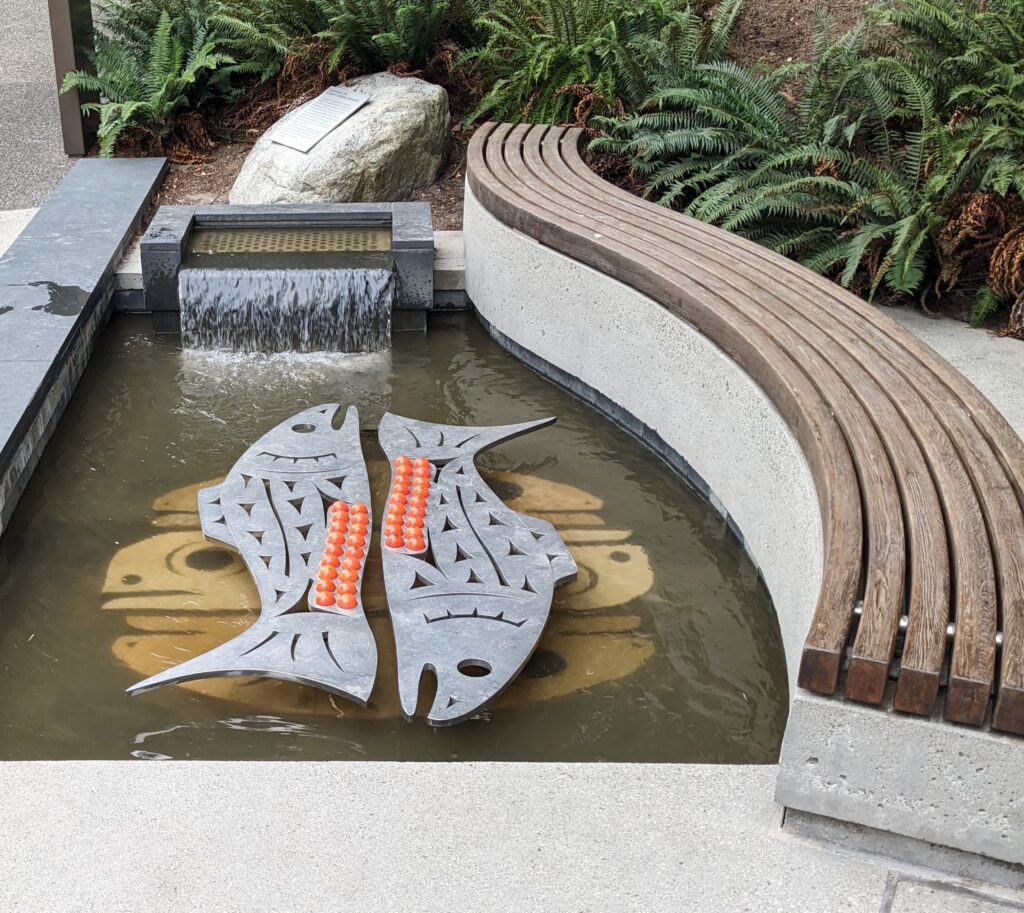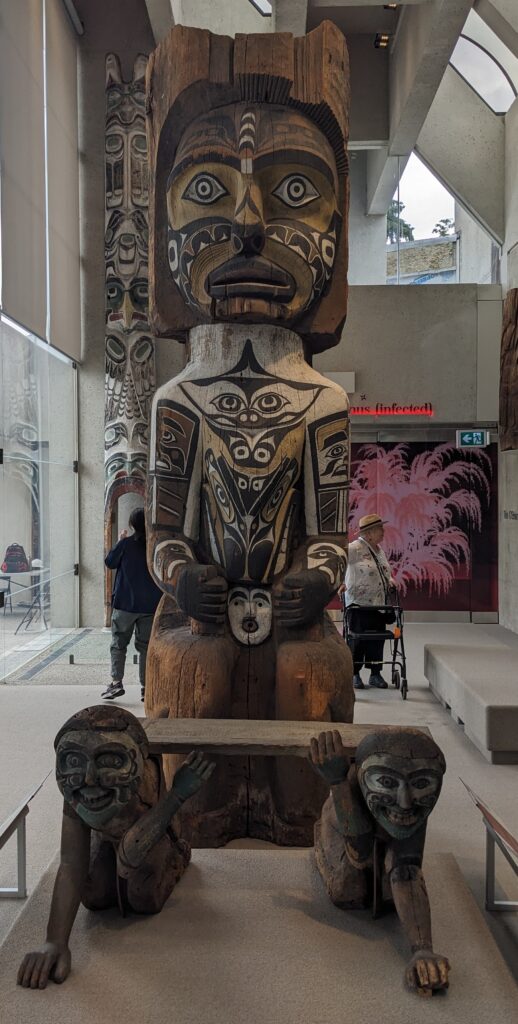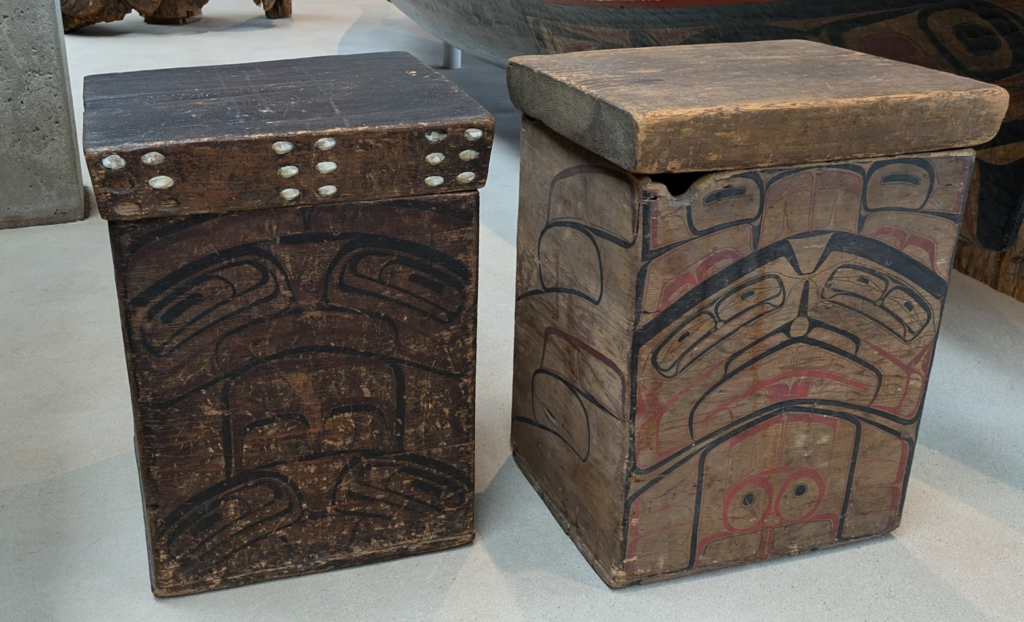
Colonialism is not a beautiful picture sometimes. When we talk about Native people, we’re wards of the Crown, we are under separate citizenship. It’s a polite way of saying you’re a slave to colonialism. It’s still “us and them.” ~ Lawrence Paul Yuxweluptun Quw’utsun/Okanagan
This was the first inscription I read on wandering into the Museum of Anthropology at the University of British Columbia recently. I had misunderstood the One & Only, and thought we were visiting an Inuit Art Gallery. Instead, we have been introduced to the culture of some of the Indigenous Canadians, and learned how they were pushed aside by colonizers in the eighteenth and nineteenth centuries, dispossessed of their land, their culture, their ancestral connections. Sound familiar?
It certainly struck a chord with me after four years of immersion into the history of our own First Nations peoples and the treatment they received at the hands of settler colonial Europeans. In Canada, as in Australia, the epithet – or should I say ‘epitaph? – ‘terra nullius‘ stated that these lands were uninhabited and therefore available to European colonizers for the taking, nonchalantly extinguishing hundreds of thousands of human beings in a single Latin phrase. In Canada, as in Australia, settler-colonial governments, ignoring Indigenous sovereignty, went to work to dispossess Indigenous nations, preventing access to resources and destroying sustainable economies that had been in place for thousands of years.

As a child, I knew nothing of the history of our country. I heard little about the history of our State. And we were no more acquainted with First Nations history than the settler colonials had been a hundred and fifty years before. The little we knew of Australian history was focussed on the era after the British landed in Botany Bay. We heard only about New South Wales, its penal colonies and its sheep farming. I had never even been to Sydney. Our history classes back then in the dark ages were completely Anglocentric, and as colonization had made that country – and the European continent – rich, its methods – the little that we knew of them – were lauded. After almost five years back in Australia, my knowledge of Australian history and the inequalities inflicted by ‘my’ people upon the Indigenous people has been on fast track. And most of it has made my stomach churn.
Back at the MOA, I found another thought-provoking reference to colonisation:
Today we have concrete. We don’t have any real forests. We don’t have salmon-bearing streams. We don’t have plants for medicine or plants to make our homes. We have to import all of that from someone else’s territory. That’s part of the colonial system: you come in and you harvest everything and leave behind devastated people. That’s how I feel: that it’s progress, but it’s not sustainable progress.
I will try to resist quoting everything I read, and at least paraphrase it. Yet it has been so compelling that I feel I must share it all with you. The parallels between Canadian settler-colonial policies and those in Australia are strikingly similar. And why not, when the origins and attitudes of those Empire Builders were exactly the same?
***
To back track a little, to where we are. UBC is a huge campus on a peninsula at the northern end of Vancouver. In the summer, the wide boulevards and shady trees are a joy, but I imagine it can be quite bleak through the winter months, when the skeletal trees bare their naked branches to the icy winds that must whistle in from the sea. Our older son was here for a semester a few years ago, and the shock of that first winter after four years in the Philippines must have been intense.
Meanwhile, as the flower beds bloom with multi-coloured roses and the blackberries are beginning to ripen, welcome to the Museum of Anthropology, a place to explore the First Nations peoples of the West Coast of Canada, and other cultural communities that have journeyed here from every corner of the globe. The architecture of the building has been inspired by the cedar post and beam structures found in traditional Northwest Coast Aboriginal villages, with a modern twist that involves lots of glass.
We arrived on the doorstep of MOA half an hour before it opened, but once inside, our lonely vigil was over, as school children and tourists swarmed into the foyer. A quick coffee to charge our batteries and then we were off to join the fray.
Huge totem poles stand both inside and outside the Great Hall. What is a totem pole? Carved from red cedar trunks, they depict a family’s ancestry and its connection to the land. The figures of animals and supernatural beings are “crests” or symbols that represent specific ancestors and their history.
The Whaler’s pole for example, depicts – from the bottom up – the waves, a grey whale, a drowned whaler, a shaman, the crew and the harpooner carved into red cedar. Art Thompson, the sculptor, has family roots among the whale hunters on the west coast of Vancouver Island.
Haida artist Bill Reid was originally a goldsmith, but he found inspiration in the totems of his mother’s village of Skidegate and created six huge totem poles for the University of British Columbia in 1959.
Five of these stand outside, beyond the huge windows at the back of the gallery, overlooking the Salish sea. Inside, one towers above us, reaching for the sky. All portray the main crests that have been used by southern Haida over the centuries. Thus, a native artist draws on generations of ancestral knowledge, and needs to know the crests of his own and other families, their origins, and the meaning behind the symbolism. And for this, as well as his artistic talent, he is revered among his people. Many years later, Reid also carved and raised a memorial pole in Skidegate to honour his ancestors. Apparently, it was the first pole to be raised in that Haida community in over a century.
We came across Reid’s work throughout the museum. One piece in particular, was a stunning sculpture called The Raven and the First Men, which he carved from yellow cedar. The legend behind this beautiful sculpture I have paraphrased below:
A great flood had covered the earth. When it eventually receded, the sand of Rose Spit, Haida Gwaii, was exposed to the air. Raven was walking across the sand when a flash of white caught his eye. Half buried in the sand at his feet, he spied an enormous clamshell. Peering inside, he saw that the shell was full of tiny creatures, cowering in terror at his appearance. Eventually, he was able to coax and cajole them out of their shell to play with him on the sand. These tiny creatures were the first humans – the original Haidas.
***
For thousands of years, Indigenous peoples have been respecting and caring for the land, waterways, supernatural beings, flora, and fauna. They have created reciprocal relationships between human and non-human kin. This philosophy and way of being helped to maintain wealthy, complex societies with lineages connected to specific landscapes.
One Voice tells how the Indigenous Canadians learned from their ancestors to read the environment. Another Voice describes how the Elders would watch the children to see what talents or skills they displayed and then train them to excel in that particular skill.
Yet, for over a century, children were forcibly removed from their families and sent to residential schools by a government that was set on assimilating every native into its own system. It was not until 2016 that the Canadian government recognized this practice as cultural genocide; that this process actively destroyed families and communities and prevented the transmission of knowledge and language from one generation to another.
The MOA describes the mid-20th century as a turning point in the Indigenous political-rights struggle. For decades, these dispossessed peoples have been taking action. They have fought for recognition and equality, and against racism. And they are determined to reclaim their history and heritage. When the government banned dancing, they danced. When the government forbade potlatches – ceremonial feasts to display wealth or enhance prestige – they feasted together anyway. While the Christian beliefs of the colonizers were often forced upon First Nation peoples, many Indigenous communities quietly persisted with their own spiritual practices. When the Canadian Government made it illegal for any Indigenous group to pursue their land title in the courts, they fought back. They challenged conscription of First Nations men in World War II, criticized the Indian Residential School system, demanded autonomy in education, sought better healthcare and the right to vote. Refusing to be marginalised or erased, they spoke out with their voices, with their art, with their artefacts. In public spaces, where they could not be ignored, they displayed their culture and themselves, thus gaining support from prominent figures, and reminding those in power of their accountability. Subversion in plain sight!
Post World War II, human rights became central to international policy. Canada, facing increasing criticism both at home and abroad, revised the Indian Act in 1951, and dropped the Potlatch Ban from legislation. First Nations are now free to hire legal counsel and pursue land claims. Then, finally, in 1960, they were granted the right to vote in federal elections.
Today, First Nation artists and researchers wish to re-establish a relationship with the ancestral materials that were removed from their communities by colonizers who sought to collect local artifacts. Thus, we were able to examine not only recreations of the family totems and canoes, but traditional masks, feast dishes and painted chests used for storage, as furniture or for dowries. Such items were inherited, exchanged and traded among First Nations families along the Northwest Coast.
These days, First Nations, Inuit and Métis artists are using their art to re-establish a cultural identity in Canada. When Eric Robertson was asked to create a piece for the Museum of Anthropology, he wanted to find something that linked all the coastal Indigenous nations. His explanation of these two totems reads:
Lahal, or the “bone game,” is an ancient and contemporary practice that relies on non-verbal signals and gestures, and brings people together. Another common link…is the persistent assertion of rights, title, and sovereignty… Despite the accumulating wins, this particular game continues.
The game continues indeed, both in Canada and Australia. Ted Walkus, hereditary chief of the Wuikinuxv Nation in Rivers Inlet, B.C. is quoted at the MOA: ““We’re survivors… we’re still here, we’re still practicing our culture. We carry our ancestors with us. This is our story. This is who we are.”
Like us, many non-Indigenous Canadians are trying to promote a national focus for reconciliation between Indigenous and non-Indigenous Canadians. They, too, use an acknowledgement of country to shows respect for the Traditional Aboriginal Owners of the land on which a meeting or event is being held. I recently found a sign in a small park above the sea in Tsawwassan, Vancouver that put it beautifully:
The City of Delta acknowledges that this is the shared, traditional, ancestral, and unceded territories of scəw̓aθən (Tsawwassen), xʷməθkʷəy̓əm (Musqueam), and other Coast Salish Peoples. We extend our appreciation to these First Nations for the opportunity to enjoy this land together.
I love that last sentence. It gives me hope.
*The photos were taken by the One & Only and me – but I can’t remember whose was whose!




